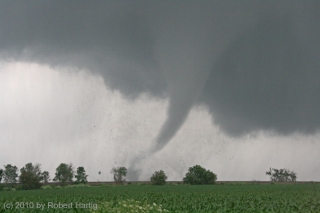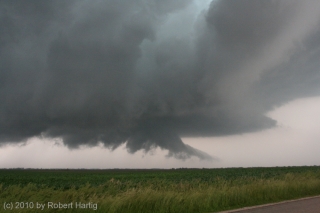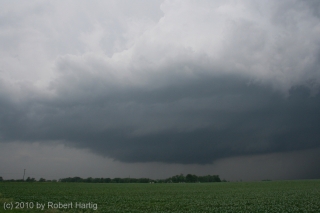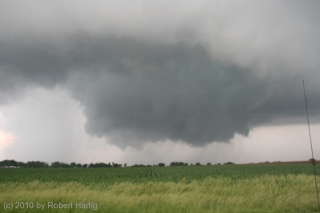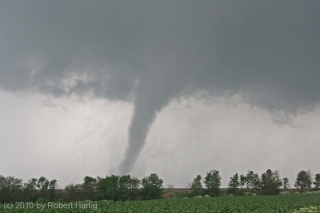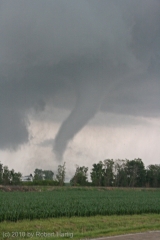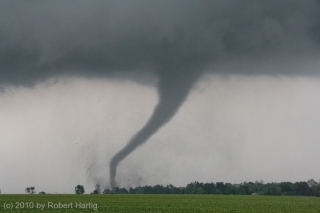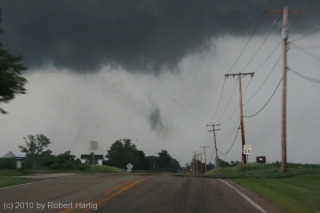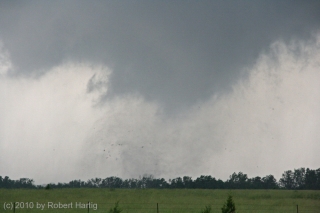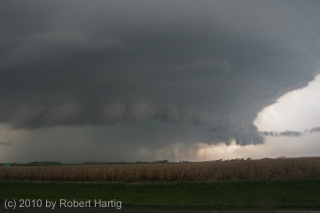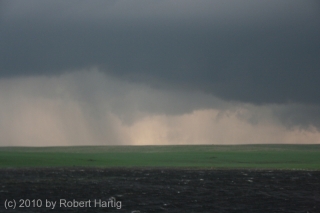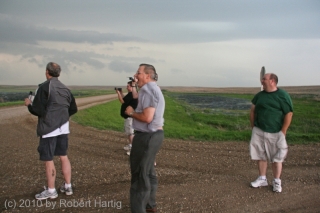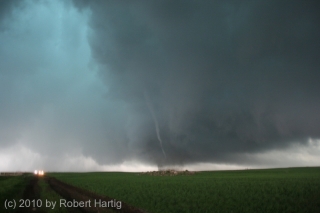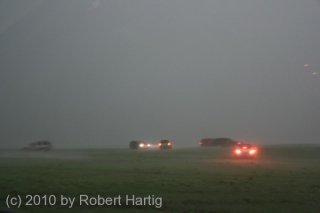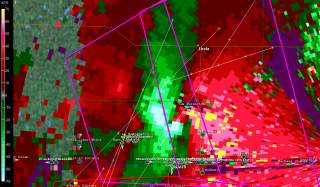This is the last installment of my account of the drama that unfolded for a number of storm chasers, including my group of four, on May 22, 2010, in northeast South Dakota. I’ve waited to share this part because it’s personal–not a deep, dark secret, but something which until now I’ve kept to myself and a few friends. It is, however, an incident I’ve wanted to write about, and with seven months passed and Christmas just a few days away, now seems like an appropriate time to do so.
If you were one of those who were out there in the field that day, you’ll agree that we were fortunate to have escaped without injury when the outcome could easily have been quite different. Perhaps the greatest gift we have this Christmas is the fact that we’re all here to talk about our experience. You were there; you know how it was. It was a hell of a ride that has made for a story we’ll probably tell and retell the rest of our lives, but at the time there was reason to wonder just how much longer our lives would last.
For the rest of my readers, you can read my detailed account including photos here. I’ll summarize by saying that a routine move to reposition east of a violently tornadic supercell near Roscoe turned into a trap when the road–which showed as a through-road on our mapping software–dead-ended where a farmer had recently plowed it over. As tornadoes began to spin up just west of our contingent and head directly toward us, all seven or eight vehicles drove madly south along a fenceline in a desperate attempt to outmaneuver the worst part of the storm. A quarter-mile down, blocked by ponding, we turned into the field and drove another hundred yards or so until we could drive no farther. Then we parked, braced ourselves, and hoped for the best. And those who believed in a loving, watchful God, prayed. I was one of them.
I’m writing this post to thank my heavenly Father for not only responding to those prayers, but also, as I have intimated above, for letting me know in a personal and moving way that He was there with us in that field, present and protecting us all.
Spiritual topics trigger different things in different people. So let me make something plain. I write as a disciple of Jesus; I do NOT write as an emissary of contemporary Churchianity. Jesus I love, but I don’t care for much of religious culture, any more than I care for boxes of any kind. So whether you’re a Christian or a non-Christian, kindly resist the urge to stick me into a nice, tidy category that would likely say more about you than about me. I know the questions that arise surrounding answered–and unanwered–prayer. I also know the conclusions people easily arrive at, both pro and con. My purpose isn’t to address any of that in this post; rather, I am here to tell you a story and let you make of it what you will.
As Mike’s Subaru Outback bounced along the fenceline behind the vehicle in front of us, grinding its way into and out of muddy potholes, I had a good view to the west from the passenger’s seat. Rain bands spiraled and braided, hinting at unseen vortices. At one point, to my considerable consternation, I saw twin funnels wrapping around each other like a pair of dancing snakes, moving straight at us. They reminded me–I kid you not, so please don’t shoot me for saying this–of the “sisters” in the movie “Twister.” I’d estimate that their distance from us was around 150 yards. My buddy Bill Oosterbaan saw them too.
That was the moment when I realized we were not going to outmaneuver the storm, and the words “seriously screwed” took on a whole new dimension. It dawned on me that now would be an excellent time to pray, and I did, earnestly. I don’t remember my exact words, but the gist of them was that I asked God to protect us, all of us. The scenario was bathed in a strange sense of unreality, and it seemed incredible to think that I was praying for my life. But that was in fact what I was doing.
Whatever happened to those serpentine vortices I don’t know. Evidently they dissipated before they reached the fenceline. But their image lodged in my mind, and it got called back the following day in an unusual way, as you will see.
At length our caravan’s flight for safety ended in the manner I’ve already described above, and the storm descended on us in full fury. On Stormtrack, a chaser recently shared some radar images of that phase of the storm, and in one of them, you can plainly make out not just one, but two eye-like features passing directly over and just north of our location. Suffice it to say that the rotation above us was complex and broad. I remember a fierce wind that seemed to constantly switch direction, and mist driving along the ground at high velocities along with the rain. A tornado spun up briefly about a hundred feet from one of the vehicles; I didn’t see it, but Adam Lucio captured it on video* and my eyes just about popped out of my skull when I saw the clip. Daaaaamn! Any closer and…well, who knows, but it probably wouldn’t have been a pretty picture.
Fast forward past the rest of the storm and the miserable drama that ensued. It was the following day and I was sitting in a hotel room in Aberdeen. I fired up my laptop, logged into my email, and…hey, what was this? A message from my friend Brad Doll. Hmmm, cool! Brad and I rarely email each other. Curious, I opened his note.
I wish I had saved it–I thought I did, but I can’t locate it. Otherwise, I’d quote it exactly. But it’s easy enough to recreate the essence of it: “Hey, brother, just thinking of you and your love for tornadoes and thought I’d share this picture with you.–Brad”
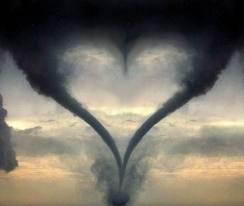 I opened the attached file. It contained the obviously Photoshopped picture you see here of two mirror-image, snaky-looking tornadoes with a funnel dividing the clouds between them, forming a heart. You can find the image without much trouble on the Internet, but I had never seen it before. As I looked at it, the snaky double-funnels I had seen yesterday popped into my mind. The similarity was weird–not that the previous day’s very real tornado resembled a heart; the only thing it looked like was scary as hell. No, it was the overall shape of its twin vortices and the way they had appeared in relation to each other that struck me.
I opened the attached file. It contained the obviously Photoshopped picture you see here of two mirror-image, snaky-looking tornadoes with a funnel dividing the clouds between them, forming a heart. You can find the image without much trouble on the Internet, but I had never seen it before. As I looked at it, the snaky double-funnels I had seen yesterday popped into my mind. The similarity was weird–not that the previous day’s very real tornado resembled a heart; the only thing it looked like was scary as hell. No, it was the overall shape of its twin vortices and the way they had appeared in relation to each other that struck me.
Then it hit me. Brad didn’t have a clue where I was. He had no idea what I’d just been through. And he had never emailed me an image file before. Not only was the communication in itself unusual, but the timing of it was…well, it was incredible.
I could feel the tears coming to my eyes as the realization sank in. This email wasn’t from Brad. Not really. Brad was just a humble and available scribe; the message was from my Father, my wonderful heavenly Father. It was His way of saying, in a simple but powerful way, “Bob, I love you!”
What I’ve just written is something I believe with all my heart. God knows us through and through. He knows what makes you, you, and me, me; and He knows how to speak to each of us intimately, in ways that touch us in deep places if we have ears to hear. Here is what I believe He was saying to me:
“Bob, when you, Tom, Bill, Mike, and the rest of the guys were fleeing along that fenceline like scared rabbits, I saw you. I heard your prayer and the prayers of all who called on Me. And I was with you. My hand covered you and my presence protected you all–because I love you all, every last man of you who was there. Today, Bob, I’m letting you know that I truly was there–that yes, it was Me–and that I carry you in my heart.”
I am not one who calls every unusual thing that happens a miracle. I believe that genuine miracles are rare, and I dislike devaluing their reality by sloppily misapplying the word. But I also believe in grace, and from time to time I have witnessed extraordinary examples of what it can do. After receiving the email from Brad, I am convinced that what happened in the field on May 22 was one of those occasions. Things could easily have turned out far worse for those of us who were there. Instead of a joyous Christmas, this year could have been one of great sadness for our loved ones, and of an empty chair at the dinner table–a chair that once was ours. But this Christmas will not be that way. We will sit down once again with our families, and we will eat, and we will exchange gifts. We will get on with the rest of winter after the holidays. And we will return to the Great Plains this coming spring to enjoy another season of chasing the storms that we love.
Just about anything can be written off as coincidence, just as almost anything unusual can be written in as a direct act of God when it wasn’t necessarily so. It’s a matter of one’s worldview. If, having read my account, you’re inclined to consider my experience just a peculiar fluke, perhaps not even all that strange, then so be it. I can’t prove differently to you and I don’t feel that I need to try. But I most definitely believe otherwise, as does my friend Brad, and Tom, and Bill, and, I am sure, at least a few others who were there in the field.
It takes faith to see God’s kingdom, and faith is perhaps best described as an extra faculty, a sixth sense that augments the first five senses. It perceives and understands differently, and sees a different and higher reality behind the stuff of our lives. It is believing, but it is also a kind of knowing that I’ve never been able to describe satisfactorily. Like the color blue, once you’ve seen it, you know what it is; but whether you’ve experienced it or not, blue is blue, and so it is with the kingdom of heaven. However accurately or inaccurately, faith is the eye that sees it.
To my wonderful Lord, Brother, and Forever Friend, Jesus, whose birth I gratefully celebrate this season: Thank you–for so much more than I can begin to tell. And to my friends and fellow storm chasers, brothers and sisters of the skies, saints, sinners, seekers, wherever your worldview stands: May your Christmas be marked by grace. And may there be great steak and good beer in store for all of us this coming year.
Merry Christmas,
Bob
__________________
* You can see Adam’s clip along with more footage from the field, plus a whole lot more, on the DVD “Bullseye Bowdle,” produced by the lads at Convective Addiction. If you enjoy storm chasing videos, this one’s the real deal–and no, the guys haven’t paid me a solitary cent to plug it here.
